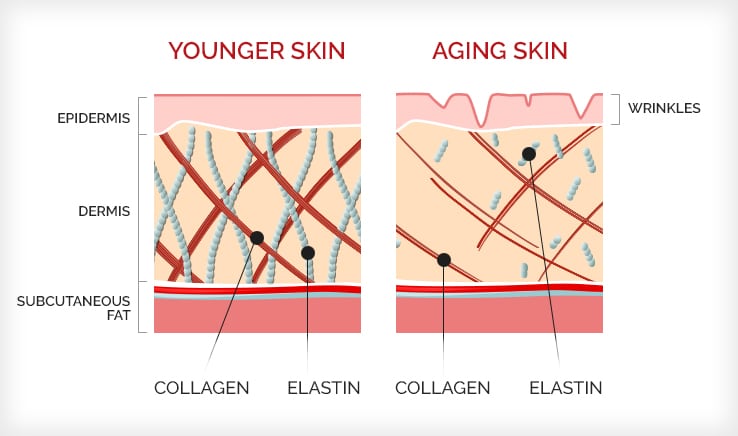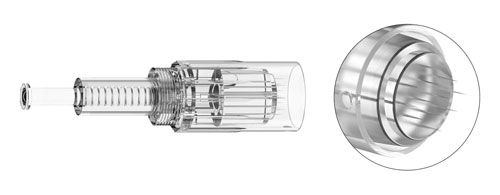 Microneedling has been around for several decades so it's a concept many have heard of. A South African plastic surgeon, Dr. Fernandes, developed the first microneedling device, which he called the Dermaroller. Tiny needles were used to create controlled micro-injuries in the skin as a way to enhance the absorption of topical skincare products and improve various skin conditions.
Microneedling has been around for several decades so it's a concept many have heard of. A South African plastic surgeon, Dr. Fernandes, developed the first microneedling device, which he called the Dermaroller. Tiny needles were used to create controlled micro-injuries in the skin as a way to enhance the absorption of topical skincare products and improve various skin conditions.
Since then, microneedling has evolved, and various devices and techniques have been developed to refine the procedure. We now understand that the micro-injuries can stimulate collagen and elastin production, which are essential for skin re-modelling.
The science behind microneedling is based on a simple yet profound principle: the stimulation of the skin's natural healing processes. At its core, the procedure involves the controlled creation of micro-channels within the skin, prompting the body to have a controlled inflammatory response. This produces collagen and elastin, two crucial proteins responsible for maintaining skin elasticity, firmness, and a youthful appearance.

As the name suggests, microneedling devices are equipped with ultra-fine, sterile needles. These needles penetrate the epidermis and reach the dermis, the second layer of skin. These micro-injuries are deliberately created, triggering the skin's wound healing response without causing significant damage. As the body works to repair these micro-injuries, it generates new collagen and elastin, leading to improved skin texture and overall rejuvenation.

Collagen, often referred to as the skin's building block, is a structural protein that provides strength and support to tissues. Over time, factors such as aging, sun exposure, and environmental stressors contribute to a decline in collagen production. Microneedling acts as a catalyst, jumpstarting collagen synthesis and restoring the skin's resilience. The new collagen fibers generated during the healing process contribute to smoother, firmer, and more youthful-looking skin.
Elastin is another vital protein integral to skin health, responsible for maintaining skin elasticity. Microneedling not only stimulates the production of collagen but also encourages the synthesis of elastin. The combination of increased collagen and elastin leads to improved skin tone, reduced fine lines, and a more supple complexion.
Understanding the science behind microneedling is essential for individuals considering the procedure. In the following sections, we will delve into the specific benefits of microneedling and provide insights into how this innovative technique can address a variety of skin concerns.
Microneedling stands as a versatile and transformative skincare procedure that can address an array of common skin concerns.
One of the primary benefits of microneedling is its remarkable efficacy in diminishing fine lines and wrinkles. As the micro-injuries stimulate collagen and elastin production, the skin gains increased elasticity and firmness. This natural boost in structural proteins works to smooth out fine lines, soften wrinkles, and restore a more youthful complexion over time.
Microneedling offers an effective solution for individuals dealing with scars, particularly acne scars. By promoting collagen formation during the healing process, microneedling helps remodel the scar tissue, gradually reducing the appearance of scars. This makes microneedling a sought-after treatment for those seeking to improve the texture and evenness of their skin.
Uneven skin texture and tone can result from various factors, including sun damage and the natural aging process. Microneedling addresses these concerns by promoting the growth of new, healthy skin cells. The procedure contributes to a more uniform complexion, reducing the visibility of hyperpigmentation, sunspots, and other irregularities.
Enlarged pores can be a cosmetic concern for many individuals. Microneedling helps in tightening and toning the skin, which, in turn, can reduce the size of enlarged pores. The improved skin texture resulting from microneedling contributes to a smoother surface, minimizing the appearance of pores and creating a refined overall look.
Unlike more invasive procedures, microneedling is relatively non-invasive, with minimal downtime. The controlled micro-injuries induce a natural healing response, allowing individuals to return to their daily activities shortly after the procedure. This aspect makes microneedling an attractive option for those seeking visible improvements without the extended recovery associated with more invasive treatments.
Microneedling not only addresses cosmetic concerns but also promotes the overall health of the skin. By enhancing collagen and elastin production, the procedure can contribute to improved skin hydration, increased blood circulation, and a more even skin tone. These holistic benefits underscore microneedling's role as a comprehensive solution for achieving radiant and healthy skin.
Understanding what to expect during a microneedling session can help demystify the procedure and empower individuals to make informed decisions about their skincare journey.
The microneedling journey typically begins with an initial consultation with a qualified skincare professional. During this consultation, the practitioner assesses the individual's skin type, discusses their specific concerns, and determines whether microneedling is an appropriate treatment. It's a crucial step that allows for personalized treatment plans tailored to address individual needs and goals.
Before the microneedling session, it's essential to follow any pre-treatment instructions provided by the skincare professional. This may include avoiding certain skincare products, medications, or treatments in the days leading up to the session. The goal is to ensure the skin is in the best possible condition for the procedure.
Cleansing and Numbing: The session typically begins with the cleansing of the treatment area to remove any makeup, oils, or debris. Depending on the individual's pain tolerance and the depth of the treatment, a topical numbing cream may be applied to minimise discomfort during the procedure.
Microneedling Device Application: The microneedling device, equipped with fine, sterile needles, is then gently applied to the skin. The practitioner moves the device systematically across the treatment area, creating controlled micro-injuries. The length of the needles and the depth of penetration depend on the specific skin concerns being addressed.
Sensation and Discomfort: Patients may experience a mild tingling or pricking sensation during the procedure, akin to a light sunburn. The numbing cream helps manage discomfort, making the process generally well-tolerated.
Treatment Duration: A typical microneedling session lasts about 30 minutes to an hour, depending on the size of the treatment area and the specific device used.
Post-Procedure Appearance: After the microneedling session, the treated area may appear slightly red or flushed, resembling a mild sunburn. Some individuals may experience minor swelling or pinpoint bleeding, but these effects are temporary and usually subside within a day or two.
Downtime and Recovery: One of the advantages of microneedling is its minimal downtime. Many individuals can resume their normal activities immediately after the procedure. However, it's advisable to avoid direct sunlight, intense physical activity, and certain skincare products for a specified period as recommended by the practitioner.
Expected Results and Follow-Up: Visible results from microneedling may take some time to fully manifest, with improvements gradually becoming apparent over several weeks.
Microneedling is a transformative skincare procedure that, when coupled with diligent aftercare, can yield remarkable results. Proper aftercare is instrumental in ensuring a smooth recovery process, optimising the benefits of the treatment, and maintaining the health and vitality of the skin.
Following a microneedling session, the treated area may exhibit mild redness, akin to a sunburn. This is a normal response to the controlled micro-injuries induced during the procedure. To enhance the recovery process:
Avoid Sun Exposure: Direct sunlight can exacerbate post-microneedling redness and discomfort. It is advisable to shield the treated area from the sun and use a broad-spectrum sunscreen with high SPF.
Gentle Cleansing: Use a mild, non-abrasive cleanser to cleanse the treated area. Harsh or abrasive cleansers should be avoided to prevent irritation.
Hydration: Keeping the skin well-hydrated is crucial. Use a gentle, hydrating moisturizer to soothe the skin and promote healing.
It's normal to experience mild discomfort and swelling after microneedling, especially in the first 24-48 hours. To manage these effects:
Cool Compresses: Applying a cool compress to the treated area can help alleviate swelling and soothe any discomfort. Avoid using ice directly on the skin.
Over-the-Counter Pain Relievers: If recommended by your practitioner, over-the-counter pain relievers can be taken to manage any post-treatment discomfort. Always follow the recommended dosage.
During the initial recovery period:
Avoid Harsh Skincare Products: Refrain from using products containing retinoids, alpha hydroxy acids (AHAs), or beta hydroxy acids (BHAs) for a few days post-treatment, as these can be irritating.
No Intense Physical Activities: Steer clear of strenuous exercises, hot baths, and saunas for at least 48 hours to minimize the risk of increased redness or irritation.
Visible results from microneedling may take some time to fully manifest, with improvements gradually becoming apparent over several weeks. Follow-up sessions may be recommended, depending on the individual's skin concerns and goals. Regular sessions can maximize the benefits of microneedling and contribute to long-term skin health.